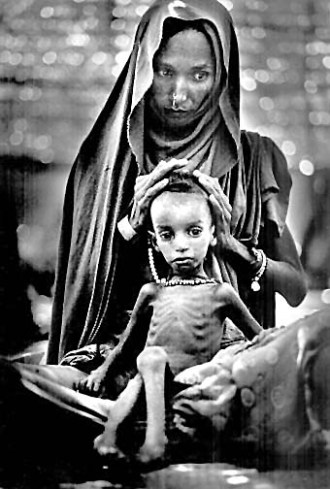The above photograph by Stan Grossfeld which won its Pulitzer prize in 1985 depicts the shocking reality of the famine in Ethiopia, captured in 1984. The famine lasted from 1983 to 1985 and effected areas of Ethiopia and Eritrea. It caused approximately one million deaths (according to One.org). From a design standpoint the image depicts what is most likely a mother and child aligned on a vertical plane with one another. The close proximity the two have to each other as well as their respective ages clearly shows their familial relationship. The rule of thirds places the child in the center with the mothers face in the square just above. The mother stands over her child cradling his head in a loving manner, her soft touch clearly shows a bond between the two; however this is not a tender photograph by any means. A look at her face reveals an unfocused stare of resigned hopelessness and it’s pretty clear why. For those raised in wealthy homes where food was never scarce her look may be unfamiliar but it speaks for itself. It is poverty. Instantly recognizable, as the look of somebody unconcerned with day to day matters of television and workplace drama, concerned only with the most basic and primal of needs: survival. “How in the world am I going to feed my family tomorrow and how will I do it the next day, and the next?” She does not have the luxury of considering anything lesser; she is a woman out of options. Though the cloak that frames her face hides much of her body, the mother’s skeletal arms can clearly be seen. Not only has this woman had to worry about finding food for her child, she has also had to find food for herself, neither of which she has likely had much luck with.
The child, who is centered in the photograph and frame by his mother’s hands, has a similar unfocused stare, not directly at the camera, but off to the side and somewhere in the distance. He looks troubled and oddly mature, as though hardship has aged him prematurely. His helplessness is of an entirely different kind; the helplessness of childhood. While the mother must worry about providing food where food is scarce, the child must depend wholeheartedly on his mother to produce food essentially from thin air. Both are powerless to control the future, but the child perhaps even more so for his lack of agency.
If one were to delve into more abstract analysis, one could say that the image has a strong religious undercurrent. The woman in her shawl, surrounded seemingly by a glowing aura with her hands brought nearly together in prayer, is strongly reminiscent of the catholic Madonna, her child then, the baby Jesus. The black and white lighting provides an almost painterly quality. Both stand upright, both dignified despite their clearly difficult conditions, both wise and hardened to the world. Beads around the woman’s wrist and the child’s neck bring to mind prayer beads, with the implication that the woman is praying for her child. Not only are we in the west meant to sympathize with these two, but also to relate to them. These are not exotic foreigners from a different land; they are not people with different customs and ideas about the world, they are avatars of some of our most recognizable literary figures. Good people just like us. People who need saving.

